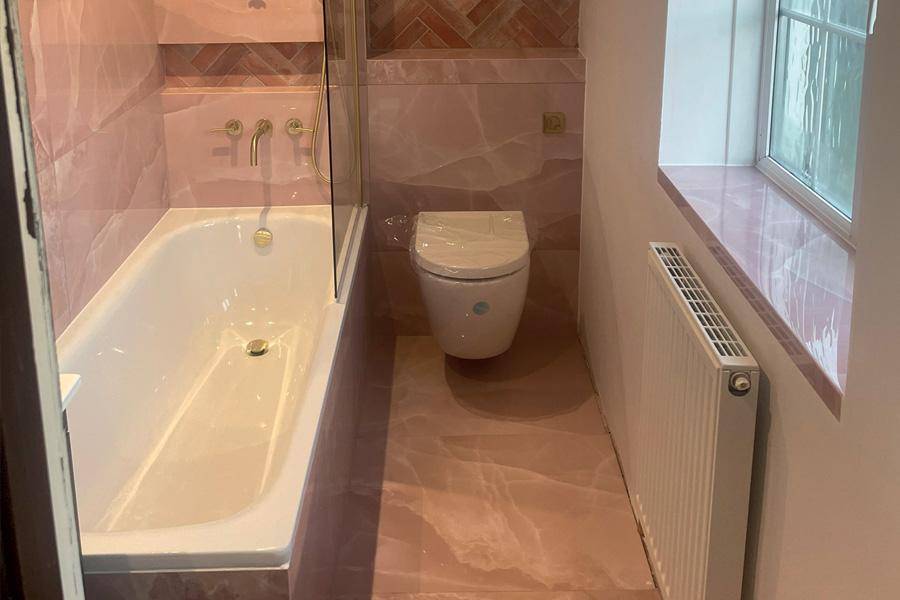Last month, we spoke with Adam of Sussex Wetrooms about his journey into the tiling industry, and explored how he became a competent, trustworthy member of the trade. Here, we delve into a few of the key concerns Adam sees with the UK tiling sector today.
In recent years, the global industry has embraced the potential of social media, with tilers now using Facebook and Instagram to share ideas about the trade, seek advice, and show off their work. It can be an incredibly useful tool, Adam says, and while there are a few drawbacks, the positives clearly outweigh the negatives in his opinion. “If people want to use it the right way, social media in the tiling industry is a fantastic resource,” Adam says.
He relays a recent story wherein another wetroom installer had gotten confused over how to put together a particular Schlüter product – how it needed to be assembled and then laid out. “So he gave me a call and said: ‘I know you’re a Schlüter guy, have you done one of these?’ And I had, so I talked him through the process. He’d found me through social media – no other way – that’s how he’d seen my work and knew what I was about.”
It’s easy to be cynical about the potential of social media to help, rather than harm people, but this story is a clear example of how it can solve issues practically no other system can. Before the advent of these online platforms, Adam would have had no way to get in touch with other tilers beyond his immediate vicinity. Now, he’s connected with almost a thousand via Instagram and yet more through Facebook, and this potential for collaboration and useful connection simply wouldn’t be possible without them. “It works both ways. Who knows what’s around the corner? I could break both ankles and I know 5 tilers I could phone and trust implicitly to finish the job I’m working on.”
Of course, there are always bad apples. “In my opinion, there are three types of tradesmen on social media. There are tradesmen like myself, who want to elevate their game within the industry and are willing to put themselves out there to help4 others. Then there are people who are only on there to criticise and look for other’s mistakes. And then there are people who are just ambivalent to everything!”
That said, overall, the tiling community seems to be unusually welcoming and friendly on social media. The usefulness of these apps, ultimately, like any platform for interaction, is dependent on the willingness of others to be a positive force in the community, and that faith in his fellow tiler is where Adam is confident. “It’s a double edged sword isn’t it. I like to think there are more positive people in this world than negative.”
Where he’s less assured though, is in the industry’s ability to guarantee good work across the board without the regulatory structure to ensure it.
Standard bearer
The issue, as Adam sees it, is the lack of a regulated standard, particularly in relation to waterproofing. “Having had many conversations with the British Standards Institute, it’s actually an untested standard. No one in the country can attain it.” That’s a problem – because water can do serious damage if it’s not treated carefully. “Last year was a depressing year of my life,” Adam reveals, “because every other job I did was a wetroom that was less than a year old and had already leaked and failed.”
Even in these cases, however, he’s keen not to blame the individual tradespeople involved, rather seeing these failed jobs as a symptom of the larger standards issue. “They weren’t cowboys, they’d done a lovely job. The rooms looked good. Unfortunately, they didn’t understand the process of the waterproofing system they’d used, and in turn, applied it incorrectly.”
So, what’s to be done? The industry is in a fortunate position, Adam says, with regards to product training, at least. “Schlüter-Systems run training on their products all year round to get people confident in using them, and to become accredited installers. Mapei does the same, so does Tilemaster and Kerakoll, Ardex and BAL. They’ve all got these huge training centres dedicated to the industry. All you’ve got to do is give up a little bit of your time.”
Unfortunately, it will never be possible to totally standardise and get every installer through this training, particularly if there’s little incentive outside of self-improvement to do so. This is where Adam believes strongly in the value of a competent person scheme – much like the Gas Safe Register for boiler installation. “I think the tiling and bathroom industry needs something, even if it’s only at a waterproofing level, to show homeowners they can have confidence in having that work carried out, because it is certified waterproof.”
While it would be possible to propose a new accreditation through UCAS, Adam says: “That is a process and a half,” and in his view, a competent person scheme could achieve the same ends with far less red tape. He mentions CORGI, the Certificate of Registered Gas Installers, as a point of comparison. “In 1971, it came about as a voluntary organisation after there’d been quite a few huge disasters around the supply of natural gas. It wasn’t until 1984 that the government came on board and actually made it a mandatory requirement. It’s not out of the question for individual bodies or manufacturers to create their own competent person scheme, and I don’t think it would take long for insurance companies to start recognising their value and start demanding works were carried out by people with those accreditations.”
This more organic approach would rely on a certain degree of take up from the wider tiling profession, but fortunately, through social media, we can see that the idea is already rather popular, Adam says. “Quite often I’ve posted on my Instagram asking: ‘Who else thinks there should be a certificate for waterproofing in our industry?’ And I will get hundred plus messages from that. Bear in mind I haven’t even got a thousand followers!”
Adam is optimistic a scheme like this could be achieved, especially with the level of communication available to the industry today. “There was no social media back then. These registered gas installers were being united by letter, by post. And they managed to form a competent person’s scheme that was so successful that after 13 years, it was adopted by the government and chosen as the only competent person scheme they would legally allow a gas engineer to be registered with.”
The idea is just that, for now, an idea, but it’s easy to see how it could improve standards in the relatively short term should tilers decide to embrace it. The process of getting the trade on board could be straightforward, or it could be arduous, depending on how widespread the desire to ensure quality installations is. For Adam, as always, there’s more work to do.
www.sussexwetrooms.co.uk









